What’s the Best Ladder for Home Inspectors?
Managing Risk
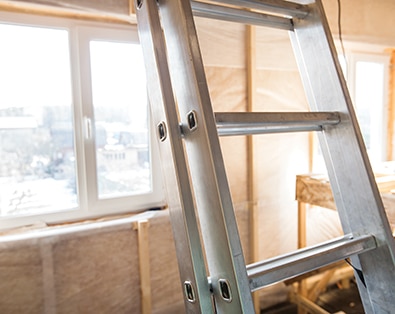
When it comes to home inspection equipment, few items are as essential as ladders. Needed for most roof inspections, ladders are an important tool. But when ladders come in so many materials, lengths, duties, and varieties, it can be tough to determine which is best for your business.
What’s more, choosing a ladder is about more than convenience. According to the Consumer Product Safety Commission, more than 500,000 people seek medical help for ladder-related injuries each year. Additionally, about 300 of those individuals die from their injuries, reports the Centers for Disease Control and Prevention. Such accidents are why, in 2017, the US and the American Ladder Institute deemed March National Ladder Safety Month.
In this article we share research, including our survey of more than 1,100 home inspectors, to help you choose the right ladder and stay safe while using it.
Choosing The Right Ladder
Several factors can help determine the most appropriate ladder for you and your job, including:
- Material
- Length
- Duty rating
- Ladder variety
- Condition
We explore each of these considerations in more detail below.
Material
Manufacturers primarily produce ladders out of wood, fiberglass, and aluminum. For carrying and transporting ladders across inspection properties, aluminum ladders are a lightweight and convenient option.
However, if your roof inspection is beside an electrical wire or other power source, using an aluminum ladder can pose an electrical shock risk.
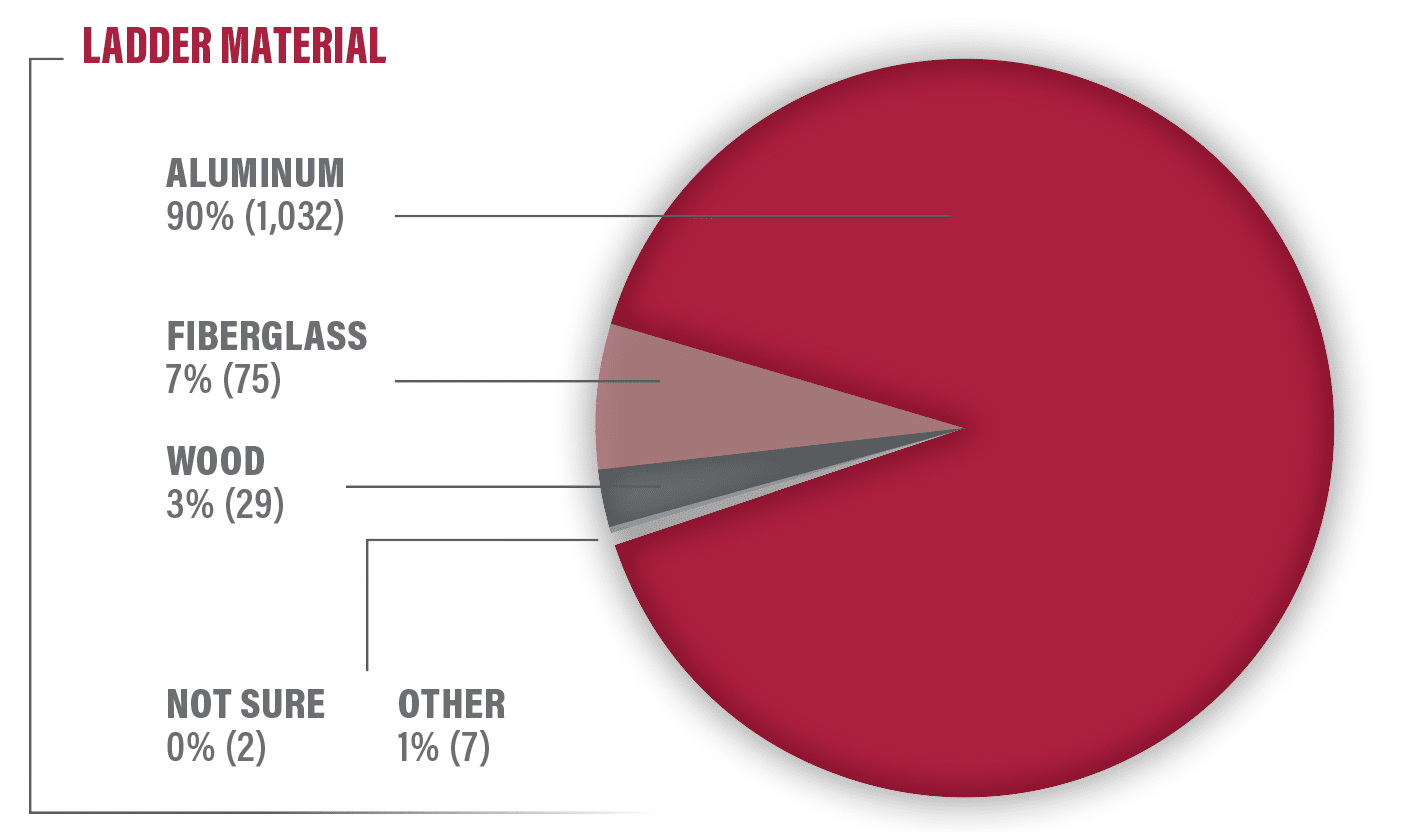
Length
It’s important that your ladder isn’t the wrong length for the job. With too short a ladder, you may be tempted to step on the top cap, which may lead you to lose your balance. With too long a ladder, it may extend more than three feet beyond the upper support point, leading the base of the ladder to move or slide out.
The following graphic shows the length of ladders our survey participants preferred.
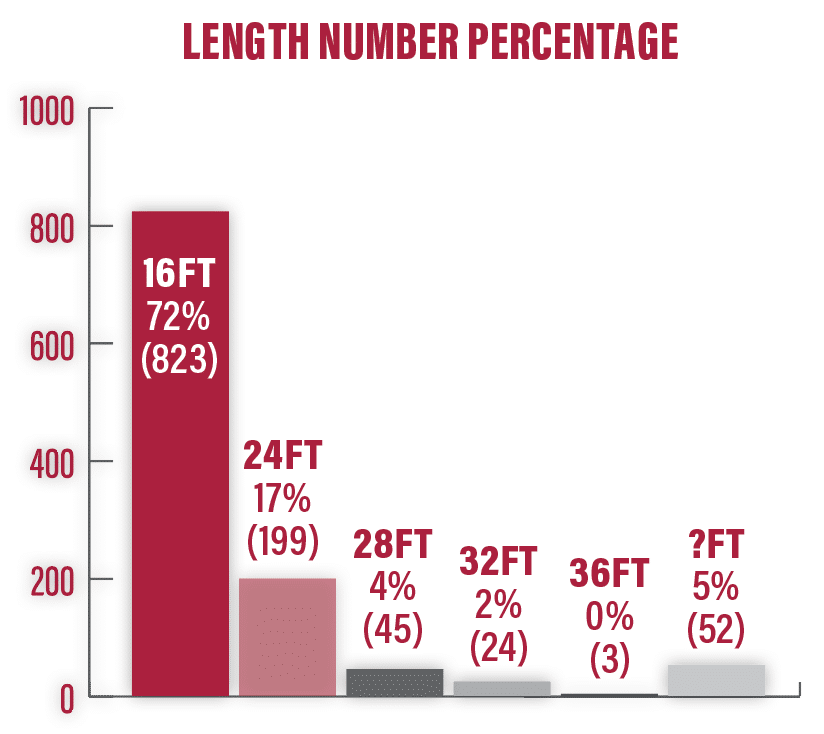
Note that the maximum working height is about three feet less than the overall length of your ladder. So if you use a 32-foot ladder, you should expect to safely climb and inspect at no higher than 29 feet.
Duty Rating
A ladder’s duty rating indicates your ladder’s maximum weight capacity. In their article “Ladders 101,” the American Ladder Institute lists the five categories of duty ratings:
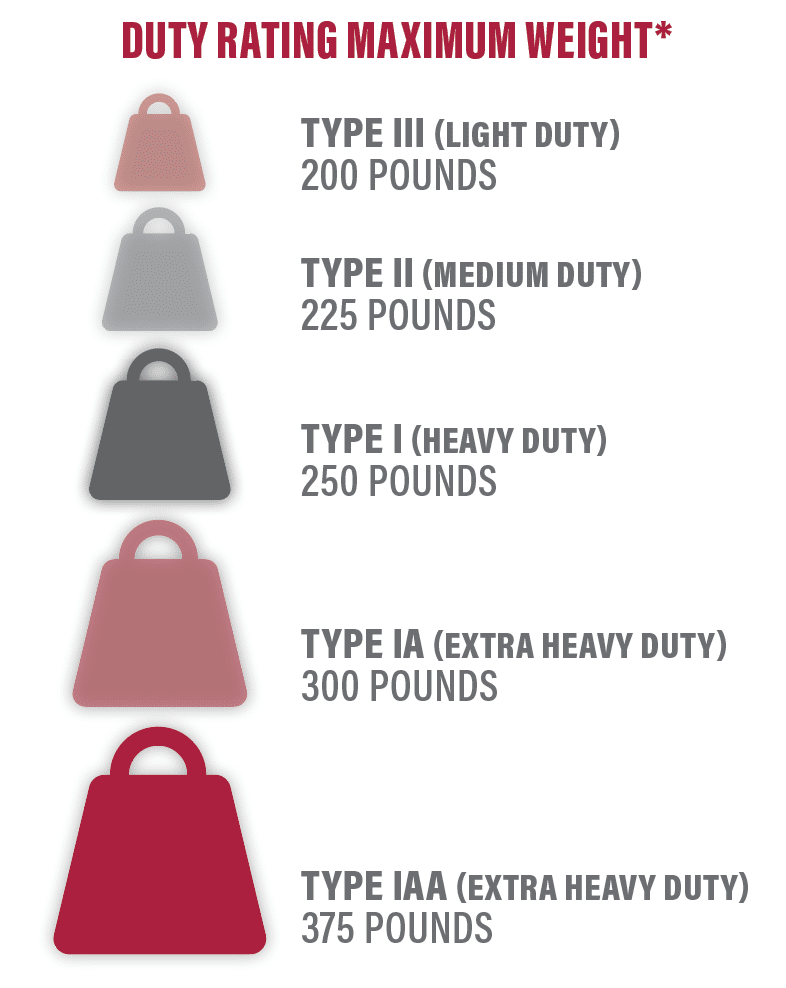
To calculate the duty rating necessary for you, the American Ladder Institute recommends the following equation:
[Your Weight] + [Weight of Clothing and Protective Equipment] + [Weight of Tools/Supplies You’re Carrying] + [Weight of Tools/Supplies Stored on Ladder]
You can find your ladder’s duty rating on the specifications label on the side of your ladder.
Ladder Variety
There are many types of ladders, including articulating ladders, combination ladders, and single or extension ladders. Each ladder type has different features and requires different safety measures and care.
Considering weight and portability, more than 67% of our survey participants said compactness and/or foldability were some of the most important features in a ladder. Furthermore, many of our survey participants use telescoping ladders. Unlike adjustable or extension ladders, telescoping ladders’ rungs can fully collapse, leaving some of these retracted ladders shorter than three feet.
To learn more about ladder varieties, refer to the American Ladder Institute’s “Ladders 101” article mentioned earlier.
In addition to ladder type, you may want to consider brands. The following illustrates which brands our survey participants favored most.
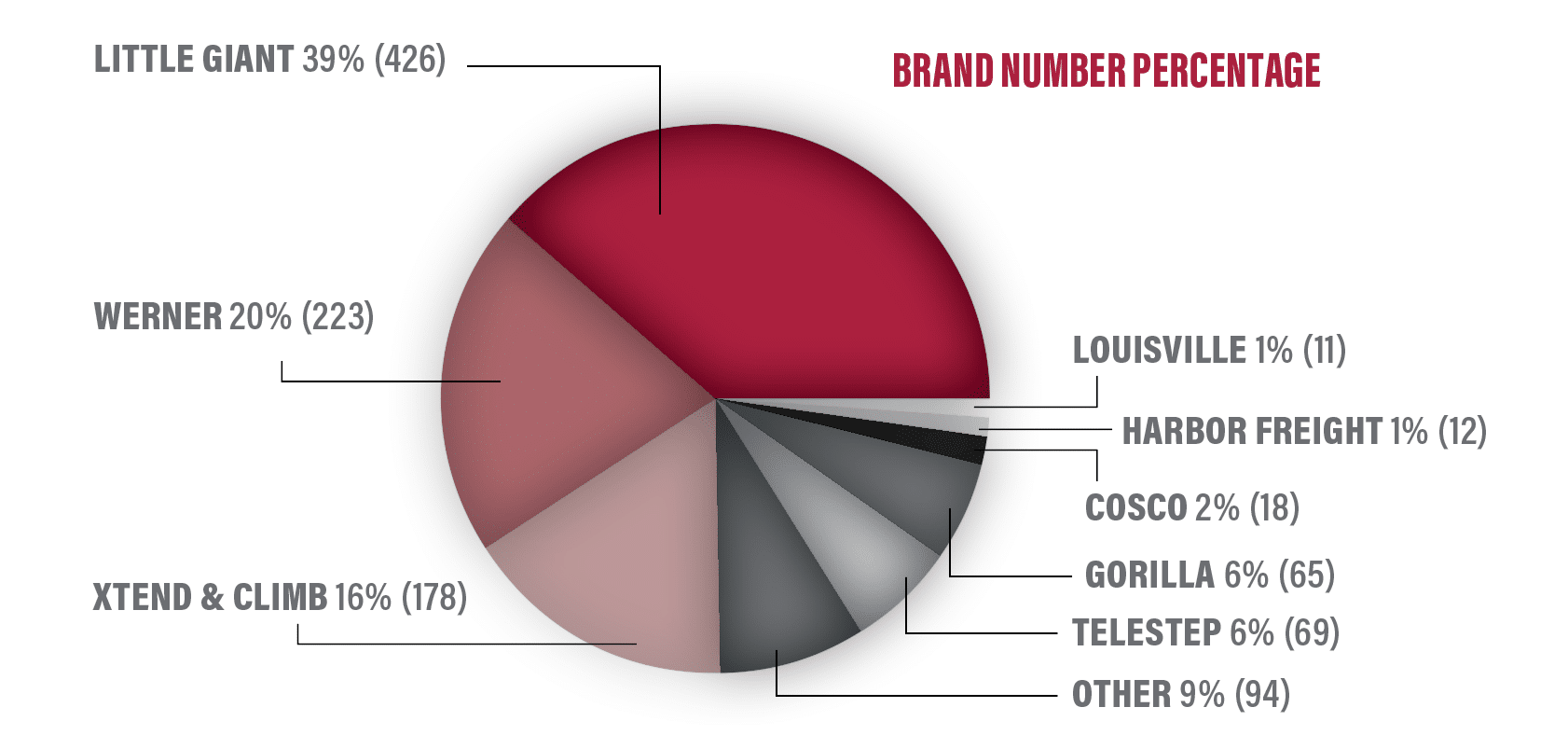
Condition
The right ladder for a roof inspection is always one that’s in good condition. Inspect your ladder regularly to confirm it’s safe to climb. When checking your ladder, here are a few items to examine to make sure they are present and properly functioning:
- Foot pads and feet for assembly and damage
- Rungs, rails, lock (dawgs), rope, and pulley assembly (extension ladders)
- Top cap, all steps, side rails, and locking braces (step ladders)
- Bracers and spreaders
If your ladder is defective or damaged, don’t use it. Replace it with a fully functioning ladder.
Limiting Your Liability
While it’s easy to consider yourself too good at your job to have such an accident, it can happen to anyone. In his article “Ladder Safety” for the ASHI Reporter, Rick Bunzel explained why assuming you’re impervious to falls is naive.
“Most of us believe we’ll never have an accident during an inspection. However, think back over the past months about how many close calls you had. How many times did the ladder jump around while you were going into the attic? Or did the ladder shift when you stepped back onto it?” Bunzel wrote.
Thankfully, falling from your ladder or a roof while on the job is avoidable. There are ways for you to manage your risk against harm. Find some suggestions on the next page.
Wear the right shoes.
According to the American Ladder Institute, bad footwear can cause falls. Thus, it’s important to wear the right shoes when climbing ladders and inspecting roofs. Here are some characteristics industry and safety experts recommend looking for in shoes:
- Flat soles since heels can get caught in ladder rungs
- Heavy soles to prevent foot fatigue
- Excellent traction and slip resistance
- Clean soles for maximum traction
There are lots of recommendations for roof inspections and roofing online, most of which point to hiking boots and skating shoes. Many caution against athletic shoes, some of which have little cleats on the soles that can damage shingles. Which shoe is best for you will depend on your budget, your feet, and the weather in your area.
Place your ladder in the right spot.
Where you place your ladder can have a significant impact on your safety. As such, it’s important to take setting up your ladder seriously every time.
“When you’ve inspected 2,000 roofs, you start taking things for granted,” said KC Bartley of Professional Home Inspections in Tennessee. “You just kind of throw your ladder down and jump on the roof.”
Make sure you always set up your ladder on firm, level ground. There shouldn’t be anything that can cause your ladder to slip at the base or top support points.
Also, look out for potential hazards in the surrounding area. If you’re placing your ladder near a door, are you sure that door is locked and not going to be opened while you’re using your ladder? Are there household pets nearby that could potentially run into and knock over your ladder?
When setting up your ladder, always open it completely so all the locks engage. If you’re using an extension ladder, follow the four-to-one rule: For each four feet of distance between the ground and the upper point of contact—in your case, the wall or the roof—move the base of the ladder out one foot.
Tell your clients to stay back.
Some home inspectors like it when clients attend the home inspection. They believe being present helps their clients have appropriate expectations and better understand your inspection findings. However, one area to which clients should never accompany you is the roof.
Do not allow overzealous clients (or agents or anyone else) to climb up the ladder after you. In fact, don’t let them anywhere near your ladder. You may consider putting a sign on or beside your ladder to encourage others to stay back. Failure to create strict boundaries around your ladder and your roof inspection could harm you or others.
Carry workers’ comp insurance.
If you or one of your home inspectors is injured during a roof inspection, workers’ compensation benefits may be available to you.
Workers’ comp insurance provides employees who suffer from work-related injuries or diseases with access to medical and wage benefits. Unlike general liability (GL) insurance, which covers inspection-related bodily injury and property damage claims for non-employees, workers’ compensation looks out for you and the people who work for your company.
“One accident can not only hurt you and maybe put you out of business, but more importantly, that employee has to have a way of making a living and getting his bills paid for if it happens on the job,” said Alan Grubb of 4U Home, Inc. in Maryland.
By covering job-related injury and illness costs, workers’ comp protects both employees and employers. Employees work under less financial risk knowing they have on-the-job protection. Additionally, employers limit their liability and deter litigation.
“If you have any employees, they need to have workman’s comp,” Grubb said. “The amount that it costs for workman’s comp is minor [compared] to what it could cost you or your employee if you didn’t have it.”
Get a quote for workers’ comp for home inspectors today by completing our application on the InspectorPro Insurance website.
Ladder and Home Inspection
Inspect roofs confidently by choosing the ladder that’s right for your business and taking the necessary precautions to avoid accidents and injuries. Learn more about National Ladder Safety Month and obtain free training, flyers, and videos by visiting laddersafetymonth.com.
Note: The Managing Risk column with InspectorPro Insurance provides home inspectors with tips to protect their businesses against insurance claims and examines best practices for crafting effective pre-inspection agreements.
The opinions expressed in this article are those of the author only and do not necessarily reflect the opinions or views of ASHI. The information contained in the article is general and readers should always independently verify for accuracy, completeness and reliability.
To Read the Full Article
ASHI offers its members unparalleled resources to advance their careers. ASHI offers training for inspectors at all levels of knowledge and experience, including resources about all major home systems. Members benefit from a vast network of experienced professionals, providing a community for mentorship and knowledge sharing..
In this Issue
2021 ASHI Awards
Renewing the Fight Against Radon
Insulation Installation Failure
10 Ways to Better Market Your Business
What to Say—And How to Say It
Postcards From The Field

FIND A HOME
INSPECTOR
Professional Networking
Grow your professional network, find a mentor, network with the best, and best part of the community that’s making home inspection better every day.
